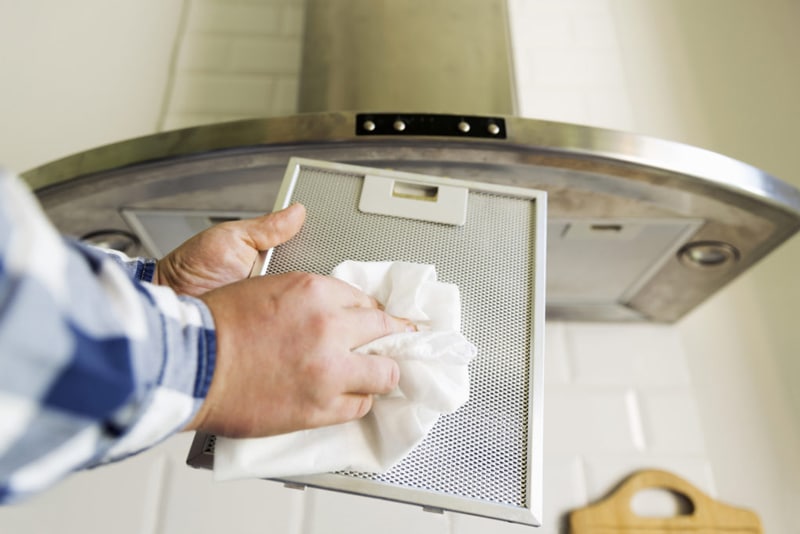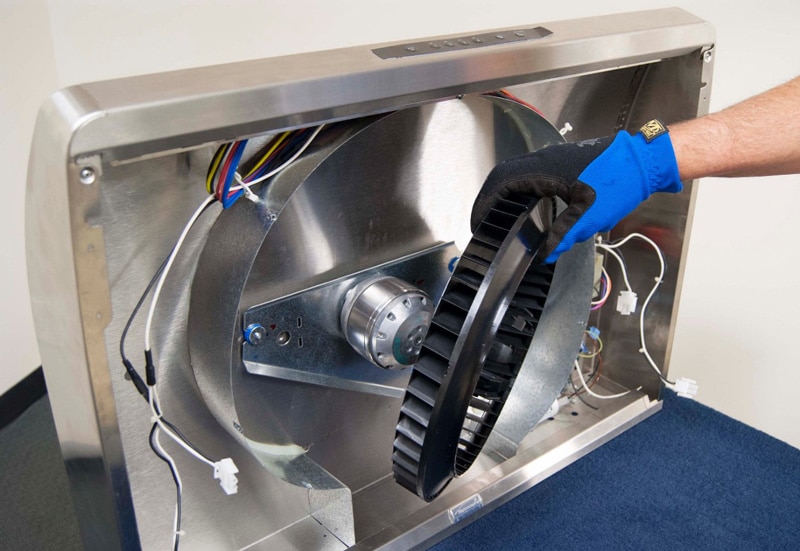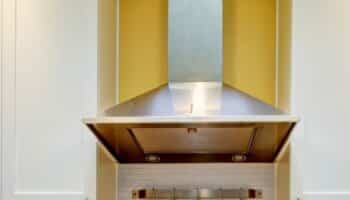Is your range hood not pulling air properly? It might be time to get some replacement parts. Here are 5 checks to make to find the problem.
Your range hood is on, but there’s smoke all around the house, what now? If you’ve noticed that your appliance is not pulling as much air as it used to, it could be due to a wide variety of reasons.
It might be as simple as clogged grease or carbon filters, or as complex as a broken or rusty motor.
Up next, you’ll find a list of all the possible causes and solutions to this issue, so you can get back to a smoke-free home in no time.
Let’s begin!
Your Range Hood Could Be Having Trouble Pulling Air Due To…
- Clogged air/carbon filters
- Having the wrong air duct
- A broken fan blade
- A broken non-return valve
- A broken/rusty motor
When a kitchen appliance fails to do the one thing it’s supposed to, it can be very frustrating. Having a range hood that does not pull air properly is the same as not having one at all.
Just like every other home appliance, range hoods need regular maintenance to avoid getting too loud or not working properly. If you have neglected yours for a while, chances are you need to replace one of its many components to get it back to normal.
Here are some of the most common culprits when a range hood is not pulling air properly.
#1 Clogged Air/Carbon Filters
Make Sure to Replace Your Filters Regularly
There are two main types of range hoods out there, those that recirculate air, and those that expel the air they pull in towards the outer world. They both have grease filters, but only those that recirculate air have carbon filters as well to clean what they pull in before releasing it back into the kitchen.
When these filters become clogged, your range hood’s capability for pulling air might be significantly impaired.

I know you probably have a very busy schedule, but this is important. If you haven’t changed either one of these in a while, it’s definitely time to do so. In fact, depending on how much you cook, it is recommended to replace your grease filters every one-three months, and your carbon filters every four months.
Solution: Replacing your filters is fairly simple. All you have to do is remove the outer vent panel from your range hood, and replace the old, dirty one with a new one you buy at any hardware store near you.
Remember that your cooking frequency will determine how quickly you have to replace your filters.
If you want to get any replacement part – or see how much one would cost – click to enter your model number in the search bar below. Our partners at AppliancePartsPros stock almost every part with free guides on how to install them.

#2 Having the Wrong Air Duct
Aluminum Flex Ducts Might Be Your Problem
While it’s recommended to avoid having a flexible aluminum air duct, some contractors might still install range hoods with them. Beware.
I understand how slashing one or two zeros from the contractor’s bill might seem very attractive, but installing the wrong air duct can cause a lot of problems in the long run.
To operate to their fullest capacity, range hood vents must have a smooth, rigid inner surface to guarantee adequate extraction of polluting, harmful chemicals.
Aluminum flexible air ducts do not meet these requirements, and thus, are advised against. If you have one of these installed at the top of your range hood, this could be the reason why it’s not pulling air the way it should be.
Solution: This is one of those things you have to nip in the bud. Whether you’re moving into a new house or building your own, make sure your range hood’s air duct is rigid and made from steel.
If this is not the case, you’ll have to call a contractor and have one installed.
#3 A Broken Fan Blade
Fan Blades Create Air Flow
Fans are the lifeblood of a range hood, as they’re responsible for most of its air pulling and extraction capabilities. When these break down, it’s like having a car with no wheels. It still turns on and looks very nice, but it’ll get you nowhere.
If you can see your range hood operating, but no air is being pulled in, this is probably the reason.
While in most cases a broken fan blade refers to the component itself not rotating, there’s also a possibility that it works, but part of it is broken, thus compromising the air flow.
Solution: Remove your range hood’s outer panel to expose the fan blade(s) in question, then carefully remove the malfunctioning component while disconnecting any wires attached to it.
Once that is done, you can place a new fan where the old one was, reconnect everything, and reassemble your range hood. If you’re unsure as to how you can do this, please refer to your user manual or call a technician.

#4 A Broken Non-Return Valve
Air flow is essential to guaranteeing that your range hood will pull air as it’s supposed to, but making sure that air cannot travel back down, is also vital. This is where non-return valves come in.
These range hood components are specifically designed so that they allow for the passing of air, but restrict the flow backwards. When your non-return valve is damaged, worn out or broken, its ability to prevent the pulled air from going back down is compromised.
Solution: Replace the part. Sadly, there’s no quick way to fix your non-return valve that does not involve getting a new one.
Luckily, they are very common, and you can find them at any hardware store, just make sure to write down your range hood’s make and model to buy the right one.
#5 A Broken/Rusty Motor
Give Your Technician of Trust a Call
Out of all the possible causes in this list, this is the worst case scenario, as the motor is one of the most expensive parts to replace in a range hood.
As you have probably guessed, this component is the heart of your appliance, and any malfunction is catastrophic. If you have tried all the previous solutions of this list and your range hood is still not pulling air the way it should, it’s time to take a look at your motor.
Sometimes the problem is not that it’s broken per se, but that it’s rusty. In either case, the sad news is that there’s no way to fix a component in that condition.
Solution: Check your warranty and call a technician you trust. Replacing your range hood’s motor is no easy task, so you’ll need someone who’s experienced in doing it.
Your technician might be able to provide the replacement, but it might be more expensive than buying your own.
You can do a quick Google search on where to find your range hood’s make and model to know the right motor to buy for the repairs.
If you want to get any replacement part – or see how much one would cost – click to enter your model number in the search bar below. Our partners at AppliancePartsPros stock almost every part with free guides on how to install them.

Conclusion
Ensuring the proper functioning of your range hood is essential to keep your home clean and free of unwanted chemicals and smells. When your appliance is not pulling air the way it should, things can get problematic very fast.
Fortunately, more often than not, fixing this issue is very simple and quick.
While some cost-effective alternatives might be appealing, in the long run, solutions like using flexible aluminum air ducts instead of rigid steel ones can end up being more expensive.
Make sure to remain in compliance with standard housing codes for range hood air ducts and keep an eye on your grease and carbon filters.
It’s a good idea to keep some spare fan blades and filters, so you can be ready to replace them whenever necessary.
Lastly, there’s no shame in asking for help. Some fixes are more complicated than others, so be sure to call a technician you trust when you feel overwhelmed.
Thank you for reading. If you enjoyed learning about this topic, why not expand your knowledge and check out the articles below?
Stay safe, and happy fixing!






